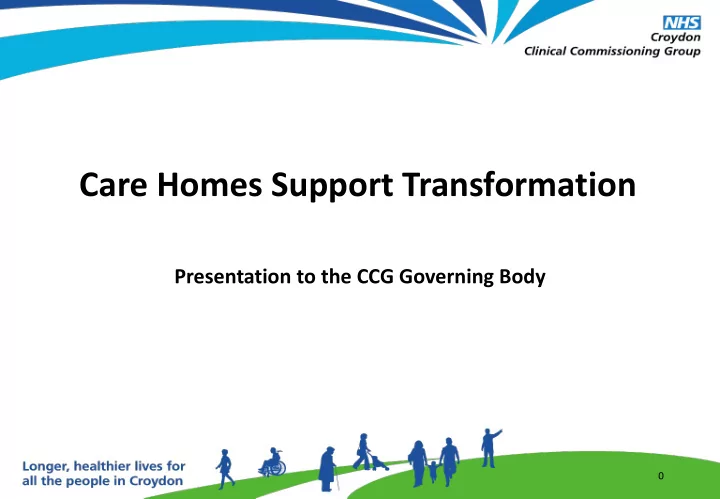

Care Homes Support Transformation Presentation to the CCG Governing Body 0
Introductions Kieran Houser – Head of Out of Hospital Care and Transformation (CCG) Dr Rachel Tunbridge – GP at East Croydon Medical Centre and CCG Clinical Lead for Care Homes
Croydon has the largest care home market of any London council: • 131 homes • 2,700 beds Purley and East Croydon have highest number of nursing and residential homes
The case for change Croydon has among the highest rate of ambulance call out rates in London: 2115 incidents in care homes between March 2017 and March 2018. Between March 2017 and March 2018, care home residents accounted for: • More than 2,000 non-elective admissions – 90% of these at Croydon University Hospital • 16,000 acute bed days There are normally considerable delays in getting care home resident back to the their home – 2,300 delayed days in 2017/18 (24% of all delayed days). Non-elective admissions for care home residents tend be long – the average acute length of stay for a care home resident in 2017/18 was 11.8 days. People who are over 65s from care homes, more likely to be admitted than patients who are not from care homes. Outcomes for patients who remain in hospital for an extended stay are likely to be poor: hospital acquired infections, de-conditioning, risk of falls etc.
The case for change Croydon Local Authority (LA) and Croydon Clinical Commissioning Group (CCG) fund approximately a third of all care home residents in the borough: • Another third are funded by other local authorities • The final third is made up of those who fund themselves. There is no existing competency and training framework for care home staff Residential home residents are increasingly frail and complex – 45% of care homes admissions are nursing home residents. National evidence shows that up to a quarter of care home residents will die within 1 year of admission (30% for nursing home residents, 22% for residential home residents). So transforming support to care homes to reduce avoidable admissions and improve quality of life for residents is essential – both for the residents of the borough and for the local health system.
How are we proposing to address these challenges?
Desired Outcomes • Nursing and residential homes supported to provide more care in the home, rather than conveying • Fewer Ambulance call outs • Fewer A&E attendances and Non-elective hospital admissions Reduced demand for GP Primary Care in and out of hours • Fewer calls to NHS 111 • Enhanced Local Directory of Service • Prioritised Community Services delivered with greater efficiency Supported and sustainable care home model • Positive CQC inspections – Reassurance for relatives and carers • Reduced LoS following admission
Current model
Target operating model Co-ordinated specialist and enhanced primary care planned Effective bed commissioning support • Joint CCG/Local Authority commissioning • strategy Support to care homes coordinated based • Combined bed requirements mapped and Planned support on GP networks more efficient use of bed stock • Complex care support team supporting Proactive care • Commissioning based on outcomes with care home residents strengthened accountability • Different teams/agencies inputting into • Commissioning linked to workforce care homes aligned to move towards MDT development support Adopting national best practice • Introducing ‘red bag’ scheme to Croydon Workforce development homes, to improve flow through Acute ) Regular training programme provided with system investment from CCG: • Designed and led by clinicians • Aligned to CQC domains (with ambitions to seen Coordinated urgent response endorsement from CQC and accreditation from a Three tier response when homes have an concern about university) • a resident: Improve confidence and competencies of 1. 24/7 clinical triage via HD videophone available workforce through telemedicine 2. If face to face contact needed following triage, rapid Telemedicine support response or GP (in hours) or OOH GP called 3. 999/conveyance to ED only if appropriate. 24/7 access for care homes to clinical triage If triage or face to face response deems no conveyance hub via HD video phone necessary, then appropriate follow up support organised • Integrated into local DoS as part of MDT support • Well connected to local services such as rapid response and complex care support Un-planned support • Significant reduction in unscheduled demand on GPs Re-active support
Timeline and next steps • January to June 2018 – business case developed • July 2018 – care home strategy board (plus sub-groups) established • September 2018 – business case sign-off • October 2018 – red bags delivered to care homes for use by nurses/carers/residents • November 2018 – other initiatives go into implementation • March 2019 – evaluation of red bags and further roll-out • March 2019 – evaluation of implementation to date and further actions taken
Any questions?
Recommend
More recommend